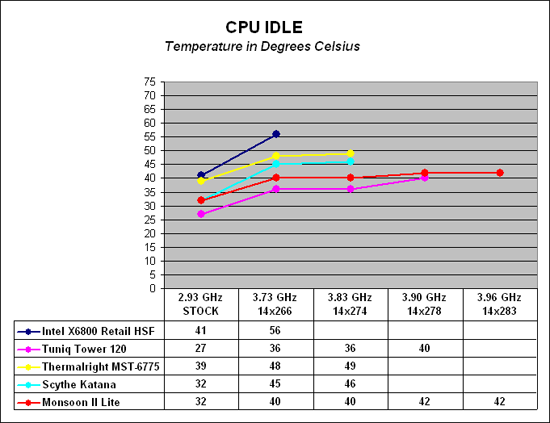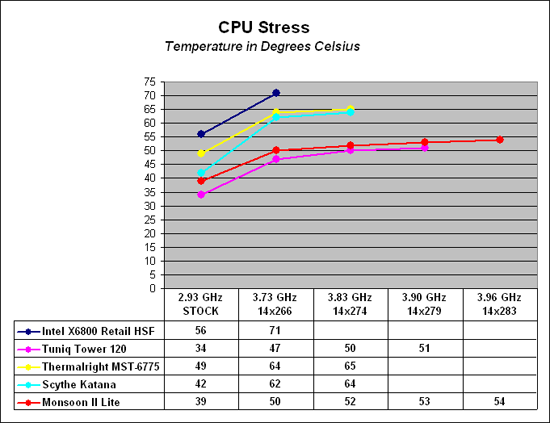Monsoon II Lite: Thermal Electric Cooling Tower
by Wesley Fink on February 6, 2007 6:00 AM EST- Posted in
- Cases/Cooling/PSUs
Cooling Results
The Vigor Monsoon II Lite is certainly one of the most effective coolers we have tested, reaching new overclock levels and matching or bettering the best performance so far in cooling.

Where the very good Intel stock cooler keeps the X6800 at 41C at idle, the Monsoon II Lite maintains 32C, which is a significant improvement. This is not quite as cool as the Tuniq Tower 120 at stock idle, but the practical difference between the 27C we measured with the Tuniq Tower 120 and the 32C measured with the Monsoon II Lite is not very significant when the design parameters of the Monsoon II TEC are considered. As processor speed increases the Tuniq and Monsoon II get closer in cooling, so that at 3.90Ghz the Tuniq is 40C and the Monsoon is 42C. The Monsoon also overclocks further to 3.96GHz.
As the processor is pushed to its highest stable overclock using the retail HSF, the delta increases. At 3.73GHz the retail HSF is running at 56C, compared to 40C with the Monsoon II. The Monsoon II and Tuniq Tower 120 perform similarly at idle speeds across the operating speeds they can achieve.
It is easy to measure the effectiveness of a cooling solution at idle - when the computer is doing nothing except running the temperature measurement program. It is more difficult, however, to effectively simulate a computer being stressed by all of the conditions it might be exposed to in different operating environments. For most home users CPU power is most taxed with contemporary gaming. Therefore our stress test simulates running a demanding game. The Far Cry River demo is looped for 30 minutes and the CPU temperature is captured at four second intervals with the NVIDIA Monitor "logging" option. The highest temperature during the stress test is then reported.
Cooling efficiency of the Monsoon II Lite under stress conditions was compared to the retail HSF and other recently tested CPU coolers. Once again the well-regarded Tuniq Tower 120 and the Monsoon II Lite were the top performers. It is interesting that the Tuniq and Monsoon II results got closer as the CPU speed under stress conditions reached higher.

The Tuniq keeps the CPU at 34C under stress at stock speeds, where the Monsoon II manages 39C. However, by 3.90GHz the Tuniq is at 51C compared to the Monsoon II at 53C - much closer results. Only the Tuniq and Monsoon II were able to reach 3.9GHz with this processor, but the Monsoon II Lite system allowed an even higher overclock of 3.96GHz, which is the highest we have reached with this CPU.
As stated many times, the overclocking abilities of the CPU will vary at the top, depending on the CPU. This particular CPU does higher FSB speeds than any X6800 we have tested, but the 3.9GHz top speed with the Tuniq is pretty average among the X6800 processors we have tested with Tuniq cooling. A few of the other processors tested with the best air coolers reach just over 4 GHz, but the range has been 3.8 to 4.0GHz. Stock cooling generally tops out 200 to 400 MHz lower, depending on the CPU, on the processors tested in our lab. The 3.96GHz with the Monsoon II is certainly the highest this CPU has seen so far.
The Vigor Monsoon II Lite is certainly one of the most effective coolers we have tested, reaching new overclock levels and matching or bettering the best performance so far in cooling.

Where the very good Intel stock cooler keeps the X6800 at 41C at idle, the Monsoon II Lite maintains 32C, which is a significant improvement. This is not quite as cool as the Tuniq Tower 120 at stock idle, but the practical difference between the 27C we measured with the Tuniq Tower 120 and the 32C measured with the Monsoon II Lite is not very significant when the design parameters of the Monsoon II TEC are considered. As processor speed increases the Tuniq and Monsoon II get closer in cooling, so that at 3.90Ghz the Tuniq is 40C and the Monsoon is 42C. The Monsoon also overclocks further to 3.96GHz.
As the processor is pushed to its highest stable overclock using the retail HSF, the delta increases. At 3.73GHz the retail HSF is running at 56C, compared to 40C with the Monsoon II. The Monsoon II and Tuniq Tower 120 perform similarly at idle speeds across the operating speeds they can achieve.
It is easy to measure the effectiveness of a cooling solution at idle - when the computer is doing nothing except running the temperature measurement program. It is more difficult, however, to effectively simulate a computer being stressed by all of the conditions it might be exposed to in different operating environments. For most home users CPU power is most taxed with contemporary gaming. Therefore our stress test simulates running a demanding game. The Far Cry River demo is looped for 30 minutes and the CPU temperature is captured at four second intervals with the NVIDIA Monitor "logging" option. The highest temperature during the stress test is then reported.
Cooling efficiency of the Monsoon II Lite under stress conditions was compared to the retail HSF and other recently tested CPU coolers. Once again the well-regarded Tuniq Tower 120 and the Monsoon II Lite were the top performers. It is interesting that the Tuniq and Monsoon II results got closer as the CPU speed under stress conditions reached higher.

The Tuniq keeps the CPU at 34C under stress at stock speeds, where the Monsoon II manages 39C. However, by 3.90GHz the Tuniq is at 51C compared to the Monsoon II at 53C - much closer results. Only the Tuniq and Monsoon II were able to reach 3.9GHz with this processor, but the Monsoon II Lite system allowed an even higher overclock of 3.96GHz, which is the highest we have reached with this CPU.
As stated many times, the overclocking abilities of the CPU will vary at the top, depending on the CPU. This particular CPU does higher FSB speeds than any X6800 we have tested, but the 3.9GHz top speed with the Tuniq is pretty average among the X6800 processors we have tested with Tuniq cooling. A few of the other processors tested with the best air coolers reach just over 4 GHz, but the range has been 3.8 to 4.0GHz. Stock cooling generally tops out 200 to 400 MHz lower, depending on the CPU, on the processors tested in our lab. The 3.96GHz with the Monsoon II is certainly the highest this CPU has seen so far.










19 Comments
View All Comments
hox - Friday, February 23, 2007 - link
Looking at your evaluation of this cooler, the screen shot you provide of the Nvidia monitoring software shows a Cpu temp of 49C and a system temp of 35C. Since you state you used this software to monitor temps during your evaluation could you please explain how the worst heat sink (intel stock cooler) started at 41C at idle. What heat sink was in place during your screen shot of the nvidia software? Also more information is needed to evaluate the product, in particular what is the fan arrangement in the mid tower case? Fan Number, CFM, size etc. The performance of each heatsink is highly dependent on the supplied flow of air, and there is considerable variability in how each heat sink works with the available flow. Knowing more about your standard set up would be helpful. Finally many users of the Qx6700 cpu have reported a higher initial tempearture value for this cpu. It would be nice to see in your evaluations an assessment of this processor as it typically runs 10 degrees C hotter than the dual core extremes.customcoms - Tuesday, February 6, 2007 - link
For more information, and real world tests by some of the top overclockers out there, check out this thread: http://www.diy-street.com/forum/showthread.php?t=6...">http://www.diy-street.com/forum/showthread.php?t=6...There are real world temperatures AND comparisons with other top cooling, including water. In essence, the results you see here are VERY typical. For instance, processors that would top out at 2.9ghz under HIGH END, CUSTOM WATERCOOLING (TDX block etc.) would then push on to hit 3ghz+ with the TEC. Personally, I'd rather spend the $90 on a the monsoon to reach higher clocks than $300+ watercooling setups, and not have to worry about leakage.
Avalon - Tuesday, February 6, 2007 - link
The Coolit Eliminator sells for about $200, and is similar to the Freezone. I'd definitely like to see a comparison of either. Good review.nickfd - Tuesday, February 6, 2007 - link
For my next rig, I want to use peltier/TEC, but I dont want a 2 pound block on my CPU. I want to use a 1/2" tube liquid loop with reservoir, radiator, and pump. Does anyone have, or can recommend a combination liquid/peltier block, or could point me in direction to look?Thanks much!
Wesley Fink - Tuesday, February 6, 2007 - link
The Coolit Freezone is a liquid/TEC combo. See comments above for more Freezone info.Tiamat - Tuesday, February 6, 2007 - link
Since the peltier "runs" at about 77 F, and it hits about 90 - 110 F in the summer depending on where you live, I wonder if condensation will become a problem for this circumstance.mpc7488 - Tuesday, February 6, 2007 - link
If it's 110 degrees in your house, I feel for you and suggest you sink the $89 towards Central A/C.In all honesty though, condensation is a concern, my brother smoked 2 machines when experimenting with Peltier cooling, water dripped from the heatsink down into the socket.
ViperV990 - Tuesday, February 6, 2007 - link
Shouldn't the target temperature on the cold side of the TEC be the case ambient temperature around the processor to avoid condensation altogether?cheetah2k - Tuesday, February 6, 2007 - link
I think that the comparison with the other coolers is very primitive. You should compare this to the likes of the Coolit Freezone or Eliminator as they too are TEC related coolers. I have the Freezone myself, and i enjoy the overclocking boost it gives my AMD FX-60 sitting stable at 3.15Ghz at 1.52vWesley Fink - Tuesday, February 6, 2007 - link
We wanted to get a wider variety of coolers in our database before tackling the Frezzone review. It should also be pointed out that the self contained six-TEC liquid cooled Freezone has a retail price of $400 and a street price of around $300. This is considerably more expensive than the $89 street price of the Monsoon II Lite. We have heard great things about the Freezone, and we do have one in the lab for testing. However, it is certainly in a different price category than the Monsoon II Lite, which is closer in price to heatpipe tower air coolers.